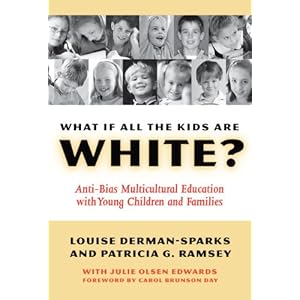 Louise Derman-Sparks, author of the seminal Anti-Bias Curriculum: Tools for Empowering Young Children (1989), has co-authored a more recent book, "What If All the Kids Are White?" Anti-Bias Multicultural Education with Young Children and Families (2003). This title, written with Patricia Ramsey, is packed with both conceptual and concrete guidance for doing anti-bias work in all- or mostly-white settings.
Louise Derman-Sparks, author of the seminal Anti-Bias Curriculum: Tools for Empowering Young Children (1989), has co-authored a more recent book, "What If All the Kids Are White?" Anti-Bias Multicultural Education with Young Children and Families (2003). This title, written with Patricia Ramsey, is packed with both conceptual and concrete guidance for doing anti-bias work in all- or mostly-white settings.The title question, the authors explain, "has been one of the most frequently asked questions in our workshops ... over the past 2 decades. Almost always posed by white teachers, it echoes the persistent confusion about the role of whites in the multicultural movement and, in particular, the engagement of white children, families and teachers in multicultural education." This book discusses why an anti-bias curriculum is essential for white children as well as children of color, and how to create a school climate that gives all children the skills to function in a diverse world. Critically, Derman-Sparks and Ramsey address the need to give white children information about how racism works.
"It is not enough to teach [white children] to embrace racial and cultural diversity; children must also develop individual and group identities that will recognize and resist the false notions of racial superiority and racial entitlement," they argue. With the caveat that, "the focus on white children in no way implies that their needs and interests should be the 'front and center' of anti-bias/multicultural education," they point out that we can't shift to a more equitable society unless white children are taught how to recognize and step out of the roles they are socialized to play.
The book advocates a "new vision of white identity" that is actively working against the privileges conferred by whiteness, and includes ideas on working with resistance and a chapter on "How Children Construct White Identities." It calls for "shifting the focus of early childhood multicultural education from 'appreciating diversity' to working toward social justice."

There's no way to convey the depth of information in this book in a short post, but here are a few of the "Strategies for Working with Children" that directly address childen's books and conversations about race:
- "Model inclusive practices... If your visual and material environment is filled with diverse images, it immediately tells children and families that this is a priority for you."
- "Make an inventory of your current educational materials and work on building a collection of materials that accurately depict the diversity within all groups (including whites) in the United States."
- "Use these materials regularly in your ongoing curriculum, not just at 'special times."
- "Regularly schedule people from different racial and ethnic groups to do a series of specific activities with your children. Ongoing face-to-face contact is probably the best way to break down barriers, recognize similarities and see differences as enriching rather than frightening or distasteful."
- "Enhance children's sense of connection with others by exploring how people meet similar needs in different ways."
- "Talk about why people have different skin colors."
The theoretical framework of the book is supported and illuminated with extensive suggestions for applications, case studies, and study questions for reflection and further exploration. Some of the richest teaching is in examples of language used by children, displaying both their confusion and misinformation about race, and their passion about making things fair for everyone.
"Use children's biased remarks as teachable moments," the authors advise. "Although children may not understand the full meaning of their biased comments, these can become the basis for more developed prejudice if adults do not respond to them. When you hear such a comment, immediately follow up with exploratory questions to gain a deeper understanding of the child's thoughts and feelings ... Use an exploratory, rather than accusatory, tone... Then plan both immediate and long-term experiences" to address the bias.
This is a practical, invaluable handbook.
No comments:
Post a Comment